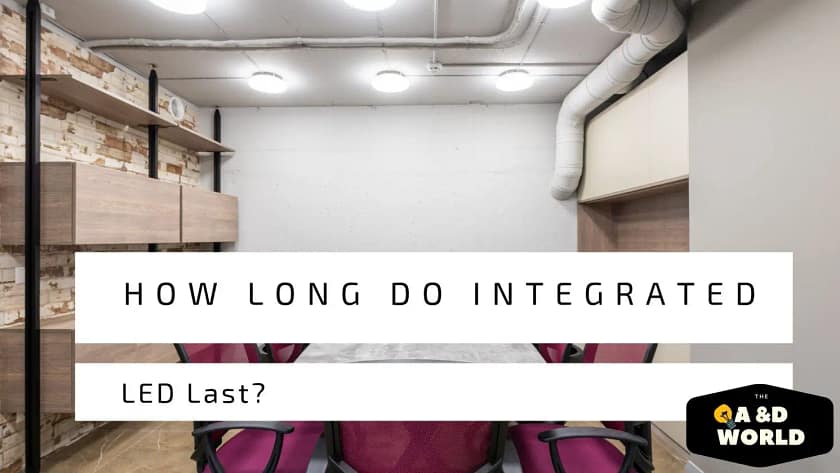Integrated LEDs have been a hot topic since they smashed the lighting market. Unlike the traditional bulbs, they do not require a socket nor a fixture. The light itself has a build-in heat sync disc, back-pan, and LEDs so, you will not find a standard socket. However, this makes replacing them a bit harder because you can not just purchase a bulb. Instead, you’ll have to replace the entire fixture.
The good news is integrated LEDs can last 20000 to 50,000 hours. These LEDs have an excellent heat control system so they can disperse heat effectively. Compared to retrofit LEDs who have to work with traditional lamps to help manage heat. As a result, integrated LEDs last 20,000 hours more than your average LED 15,000-30,000.
Below has all the information needed for homeowners who want to switch from conventional lights to independent integrated LED fixtures. You’ll find that these LEDs have many advantages with a few disadvantages. Plus, depending on the location of the light, it can make your decision worth it.
Are integrated LED lights worth it?
Apart from their long lifespan, integrated LEDs are worth every penny. For homeowners and designers who are looking for unique pieces, integrated bulbs provide just this. They are available in hundreds of styles, colors, and features. With integrated LEDs, the value outweighs the returns.
But what are integrated LED Fixtures?
It’s a lighting fixture that connects LEDs directly and with a low or line volt electrical system. Hence, it produces light by sending an electrical current to the LED microchips. The idea is to replace the traditional light bulb system with integrated LEDs.
The Pros And Cons Of Integrated LEDs
The Pros
Integrated LEDs are cheaper in the long run. Because they have all the build-in components to work without a socket, they are more expensive to build. Thus, they cost more money to purchase. But because of their very long lifespan, these LEDs require little maintenance.
Without the restriction of a traditional lamp, integrated LEDs are available in many styles and sizes. For example, integrated recessed lights sit flush in your ceiling. Compared to canisters which have a socket and metal housing.
The Cons Of Integrated LEDs
Expensive: Integrated LEDs are more expensive than retrofit because of their independent design. For instance, retrofit bulbs can cost anyway from $9 to-35 dollars. Whereas integrated LEDs cost $100-300 depending on the look and size. They are not the best option for people on a budget.
Sometimes difficult to replace: After years of use, your integrated fixture will burn out and die. If the manufacture no longer exists, it will be very difficult to locate the exact luminaire again. This is a disadvantage for recessed lighting because, if one light is different, it will throw off the overall design.
Lack of Customization: Having changeable bulbs means you can update your fixture on whatever new smart option on the market. However, once you have purchased an integrated fixture, there is no swapping for an upgrade unless the fixture stops working and there is a need for replacements.
Are Integrated LED Lights Replaceable?
Traditional light bulbs are removable, so once they no longer work, it is easy to replace. Whereas integrated LEDs have their electrical circuit boards and do not need a socket.
As a result, when they burn out, you will need to replace the entire fixture. We know this is not a bad thing, because they can last years. But many homeowners wonder if they can be replaced.
Your first step is to look at the warranty of the product.
Integrated LEDs have a lengthy warranty because they are long-lasting, so that is a pro. Hence, before you purchase these fixtures, check the warranty to ensure the manufacture will replace or repair any faulty unit.
Consider taking your LEDs to a repair shop that can fix your fixture at a lower cost. Similarly, there are videos on YouTube that can help if you repaired the light yourself.
Integrated led light fixture flickering- What’s The Reason?
When integrated LEDs flicker, that does not mean you have to throw them away. There are many causes for LEDs’ flickering, like voltage Fluctuation or dimmer compatibility.
Voltage Fluctuation –Do your lights flicker when large appliances are turned on? If so, it can be a voltage fluctuating problem. Slight fluctuations are normal. But if your home reading is over 125 volts, then this can cause the flickering issue. The best way to resolve this problem is to call your electrician to find a solution to resolve your voltage increase.
Dimmer compatibility- Many homes still use the old incandescent dimmers, and not all LEDs are compatible with them. Some LEDs work with 120VAC power and do not use a driver circuit or power supply. So with the existing dimmer, they can risk flickering. One way to tell if your integrated LED is compatible with your dimmer is to check the list the manufacturer provides. If there is none, available contact them to know which is best for your fixture.
Can you dim integrated LED lights?

Yes, integrated LEDs can dimmer. However, it needs to be compatible with a line-voltage dimmer. These LEDs can benefit from dimming. It can lower the internal temperature of the fixture, thereby raising the light output. Further, increase the lifespan of the light.
Not all integrated LEDs are dimmable. Check the packaging or features to ensure they are dimmable. Remember, these LEDs are far from retrofit so, the dimming qualities do not rest in the bulb. Instead, it is built-in the fixture.
Here is a list of my favorite dimmable integrated LEDs:
- FTS Bronze Smart LED Flood Light.
- Single recessed light dimmable.
- Drosbey 36W Dimmable LED Ceiling lights.
My Thoughts On Integrated LEDs
I’m willing to accept that integrated LEDs are worth it. However, it is not for me. Because I have some control over upkeep, I’ll remain with my retrofit bulbs. While integrated lights outlast retrofit lights, changing the fixture when it burns out does not sit well with me.
Then there’s the matter of trying to find the exact light after ten years of use. Is it still possible to locate that fixture?
Integrated lights function best depending on the location. For example, if you just need one fixture in your toilet and it does not contribute to any design aspect, it is OK to have one.




